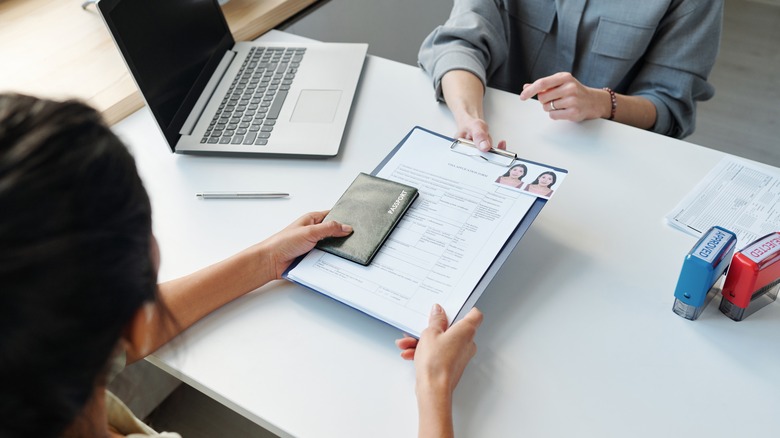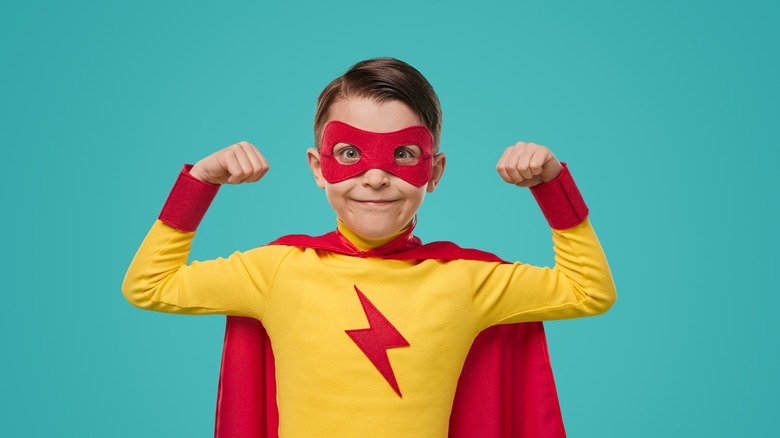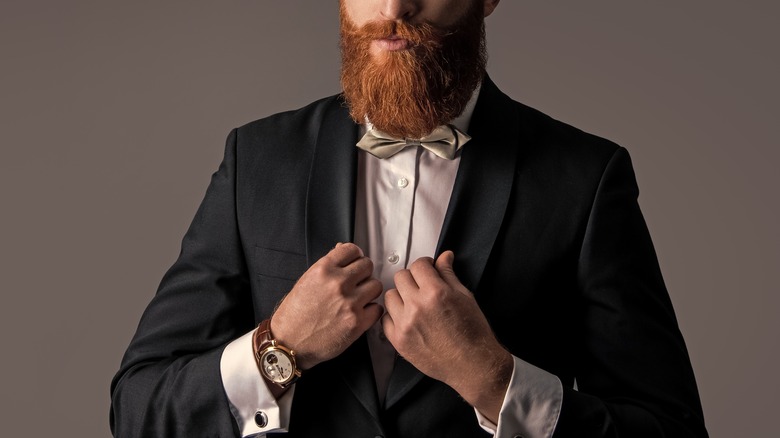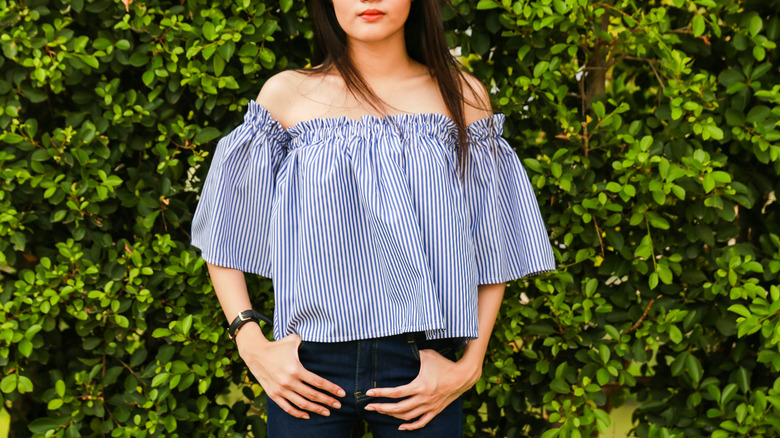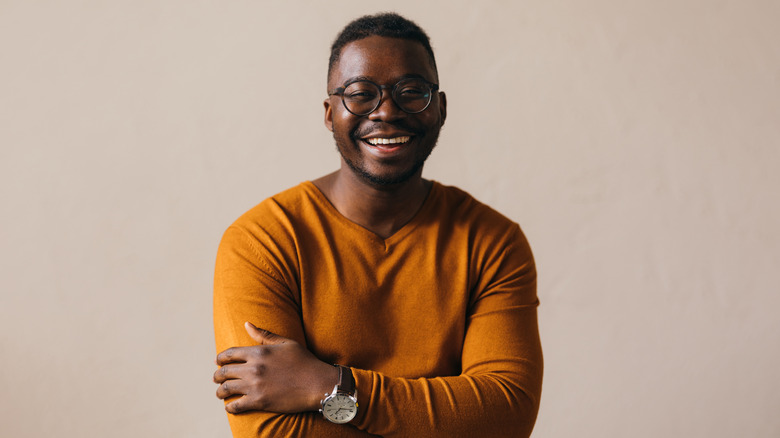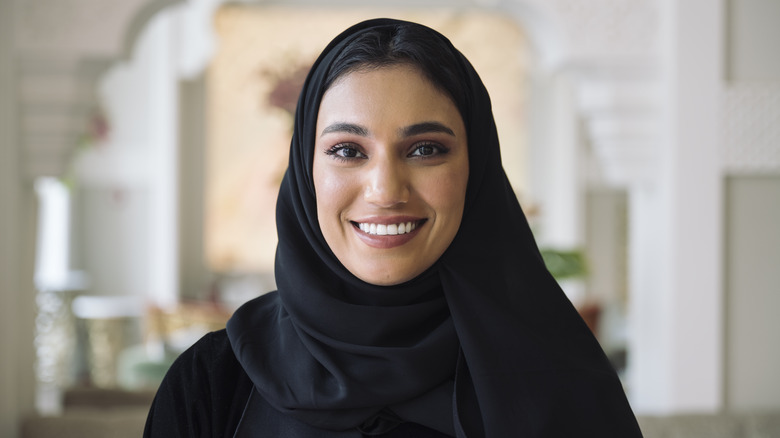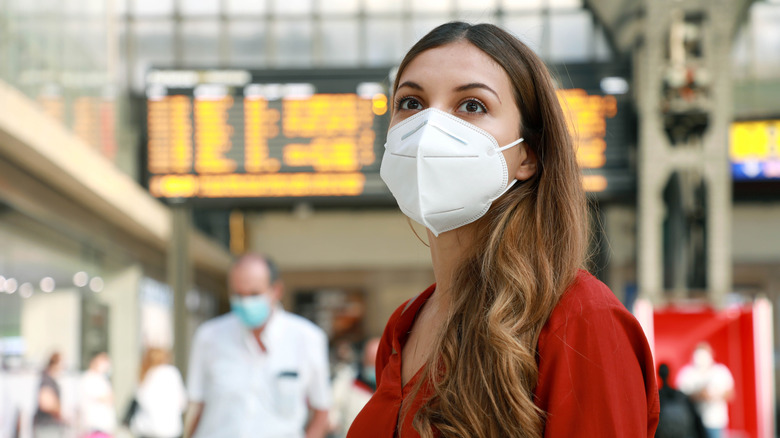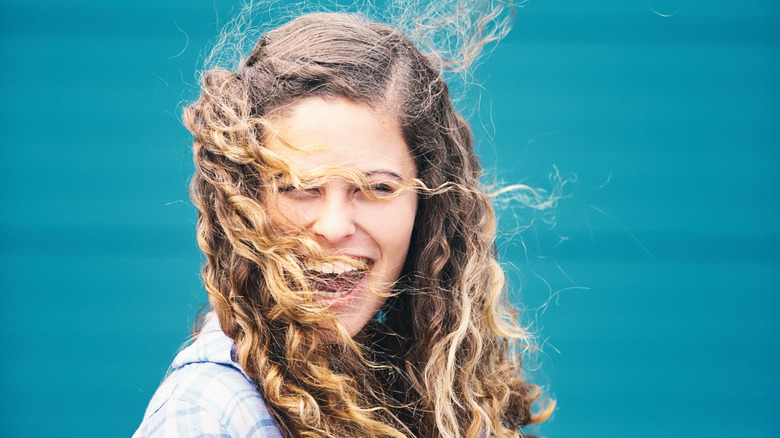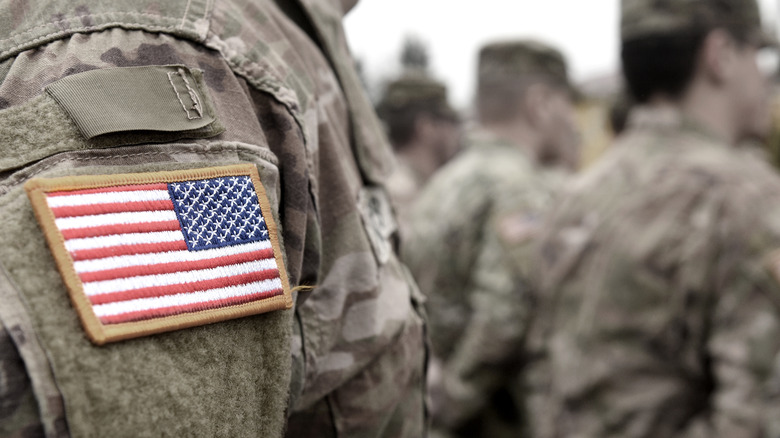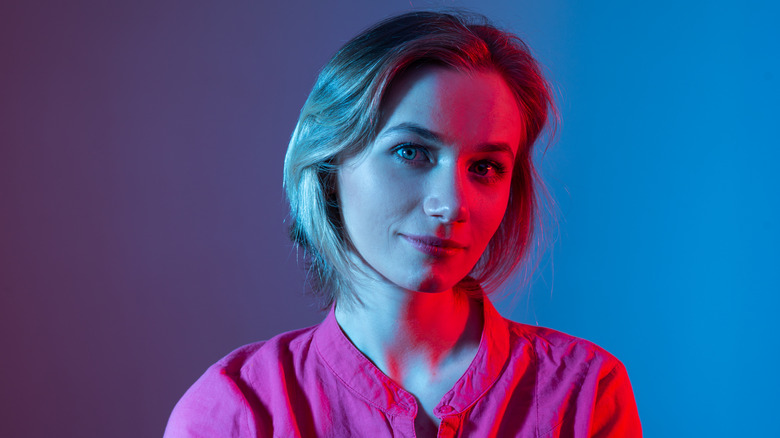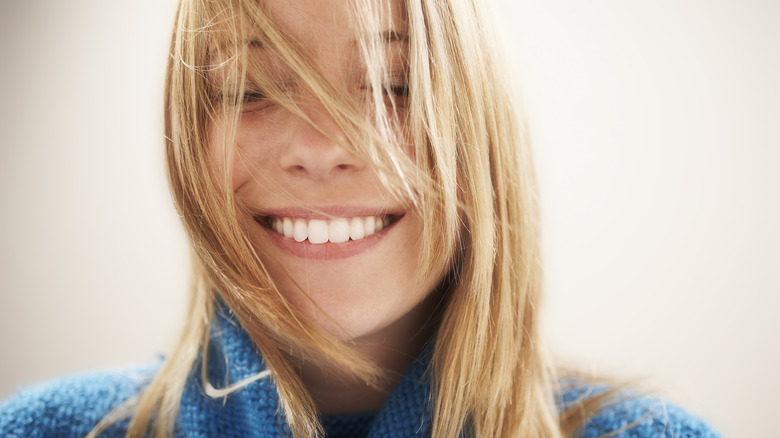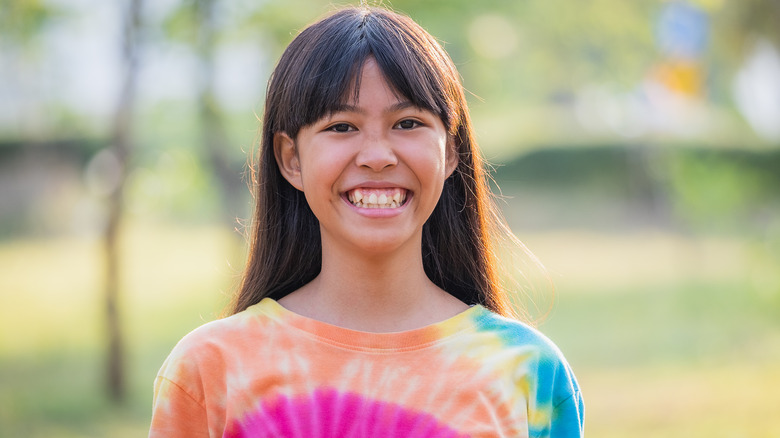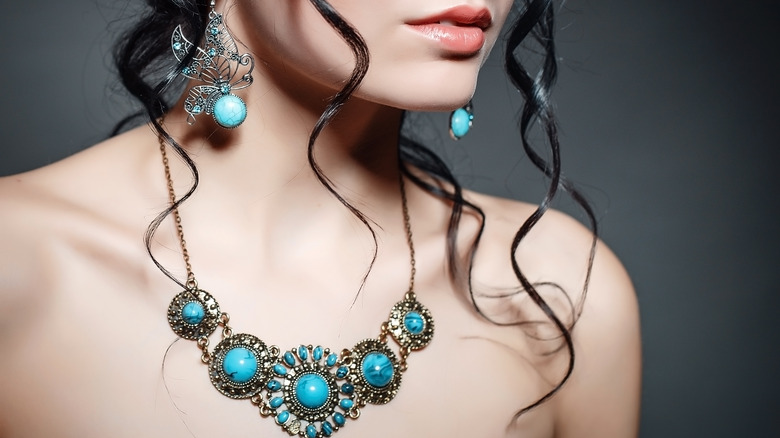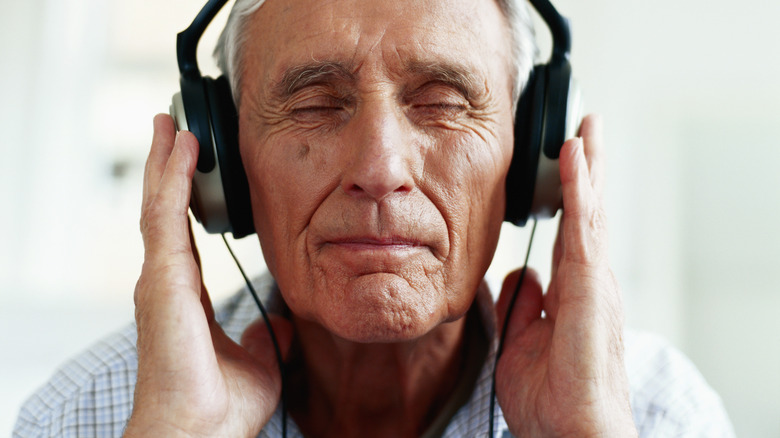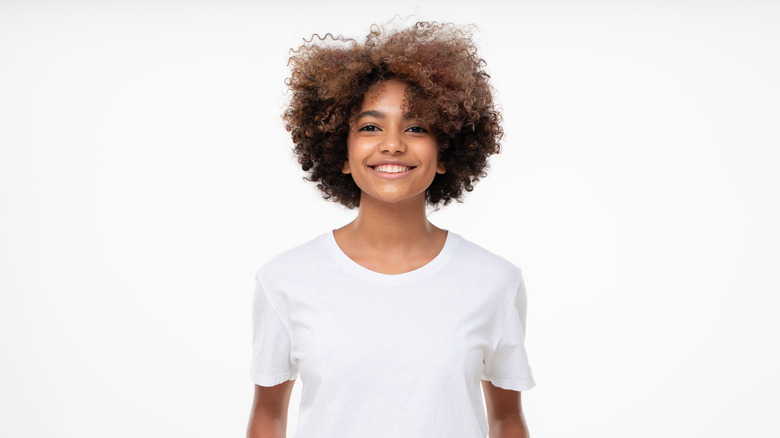Things You Need To Avoid Wearing When Getting A Passport Photo Taken
Gearing up for a trip can be exciting, but securing proper documentation can dampen your travel buzz. Obtaining a passport is non-negotiable for international travel, and it can take a good chunk of time to go through the process. One of the more tricky aspects of getting a valid passport is having your photo submission accepted, but taking a solid passport photo doesn't have to be such a hassle. In fact, you can take a passport photo at home; you just need to know the official dos and don'ts.
A denied photo is one of the main reasons a passport application can get delayed, and there are many rules associated with what you should wear in a passport photo and what you should not. The color of your shirt may affect the quality of your passport photo, and some of your everyday accessories may need to be shed before snapping a pic. These things to avoid wearing for your passport photos are a mix of strict regulations and simple suggestions, but they should help rejection-proof your passport application.
Full costumes
If you had high hopes of appearing as Batman in your passport photo, think again. While likely a lighthearted and pure wish, the U.S. government takes international transportation very seriously. By definition, a mask obscures your face and hides your identity. Representing your name and face as your identity is, at its core, the main objective of a passport, so that means no Zorro eye masks for your official documentation. Loki or Scarlet Witch's headgear, despite only covering the forehead and hairline, is also out of the question. You shouldn't cover any part of your head, even if your face is on full display.
Masks and headpieces are obviously not allowed, but it's possible you could get denied for less obvious indicators as well, like a muscled or textured shirt. With that being said, your passport photo should only be of your shoulders and up, so you could get away with an almost full costume without anyone being the wiser. If you really want to be a superhero in your passport photo, opt for a cape. Although, hidden identities are kind of superhero 101, so we doubt a passport would do Superman much good — besides, he can just fly anywhere he wants.
Formal attire
Passports are famously sticklers for formal rules, but even though they are strict with their passport photo requirements, this doesn't mean you have to show up in formal attire. You likely won't get your passport denied if you're in a suit, applicants are encouraged to wear their everyday clothing. So, forget the tux and Sunday best — instead, opt for a casual Friday vibe.
This rule may also apply to heavy makeup. If you enjoy putting on a sparkly dress and heavy makeup for formal events, think twice when dressing for a passport photo. Makeup is generally okay to wear in your photo, especially if it is your everyday look. However, once you start getting a bit heavy-handed with the makeup brush, you could start getting into dangerous, rejected photo territory. Even if your photo has been accepted, heavy makeup that has allowed you to shape-shift your features may cause you some trouble. If immigration employees don't recognize you when compared to your photo, you could be delayed or pulled aside for manual screening. Forget the formalities of looking extra nice for your photo and embrace your everyday self.
Revealing attire
Passport photos are generally cut in a way that makes it impossible to reveal anything below shoulder level. Even so, you should avoid having bare shoulders in your passport picture. While it isn't prohibited, you may find yourself running into some hiccups. Since the passport photo is cut in such a way, having a low-cut or cold-shoulder shirt could make it seem like you're not wearing anything at all.
There's nothing outright wrong with having your shoulders bared on your passport photo, but you do need to consider that this photo will be following you for quite some time. A passport is valid for a decade if you're at least 16 when you get it. In those 10 years, you likely don't know exactly where you'll be heading on your international escapades. Some countries are more strict on modesty, and you likely will want to display some if you're traveling in or through those countries. Sure, you can always reapply for a new passport, but you can avoid that by just submitting a photo wearing a T-shirt in the first place.
Glasses
There's a reason that every run-of-the-mill disguise incorporates a pair of sunglasses. A person's eyes are typically their most sought-after feature when making a connection. This means that you can be identified from your eyes alone more than some other features. In a passport photo, your eyes must be visible so that the official at passport control can compare them to the real thing. Sunglasses or any kind of tinted eyewear need to be removed before taking your photo.
You may have thought that the no sunglasses rule was an obvious one. However, you must also remove your regular prescription glasses for your passport photo. Even though you very likely wear them every day and they are considered a medical device, it is requested that you remove eyeglasses before snapping a shot. The one exception to this is if you have a signed statement from your doctor stating that your glasses can not be removed.
Hats or head coverings
No matter how much you love your snapbacks or baseball caps, you must remove them for your passport photo. For some, hats can be a major confidence booster and even become part of a person's sense of self. Remember that the government isn't trying to take your identity, they're just trying to be able to make out your likeness. This typically includes your hair and the top of your head, so even if you wear the same hat every single day, you'll have to go bare-headed when the photo is captured.
With the exception of religious head coverings, you will not be allowed to take your photo wearing anything on your head. If you regularly wear a hijab, turban, or yarmulke, you can keep them on while you sit for your photo. Unfortunately, those who wear a burqa will need to uncover their faces for their photo, as they will not be able to be identified without doing so. As long as a religious garment doesn't cover the face, it should be permitted to be worn.
Masks or face coverings
Your face must be fully visible in your passport photo, so if you're still sporting a mask in public spaces, you will need to temporarily remove it. Masks must be completely off your face and out of the photo, so simply pulling it down will get your photo kicked back. This goes for any other makeshift face coverings you use, like a bandana or other cloth coverings. For those worried about infections in public places, a workaround to this is to take your photo in the privacy of your own home.
Just because you can't take your passport photo with a mask on does not mean you can't still wear one while you travel. If you feel uncomfortable traveling without a face mask, no one will bat an eye if you walk through an airport or other transportation hub wearing an N95 respirator or similar face mask. These precautions are still recommended in high-traffic areas like airports and security checkpoints. You should be prepared, however, to lift the mask at security if you are questioned about your passport. There is a very real possibility that TSA officials will want to compare your photo to the real-life you.
Hairstyles that cover your ears or face
Hair can change dramatically in a short period, but most faces stay relatively similar over the years. As such, it's your face that needs to be on display in your passport photo. Luckily, there are no hairstyles that are outright banned when it comes to passport photos. If you want to wear your hair down, that is okay. However, it does need to be completely out of your face for your picture. It is recommended to tuck your hair behind your ears if it is long enough, but it's possible to be accepted if the hair has framed the face without obscuring any features.
What about bangs? This is a mixed bag. Bangs are accepted if they are of the shorter variety. If your bangs are long enough to cover your eyebrows, you may want to pull them back for the photo. This goes for any hair that is medium length. If there's a chance that your hair will fall into your face, slick or pin it back.
No matter what you choose to do with your hair, you will need to be wary of shadows. If your hairstyle has cast a shadow over your face, either fully or partially, that will need to be remedied. You can avoid this by pushing your hair back and using good lighting.
Uniforms
The official government guidelines for passports explicitly ban uniforms from being worn in photos. This means that if you are military, you must wear civilian clothing for your photo. It's not just our armed forces that this rule applies to, as all uniforms will get your photo rejected. If you are taking your photo right before or after work, bring a change of clothes — or a different shirt — for your photo.
This guideline is likely a safety measure. When traveling, you should be able to be identified by your photo, but not by occupation. This could create unnecessary bias. If you are military or a medical professional traveling, emergency situations could have you targeted based on this extra information if you had provided it in your photo.
Similar to the no-uniform rule, wearing camouflage will get your photo thrown out. This is not a dig at hunters, outdoorspeople, or anyone with an affinity for the color and pattern combination. Likely, it is its affiliation with the military. Bright orange camo may be okay, but we wouldn't risk it.
A filter
As tempting as it is to try to get rid of flaws and insecurities after taking a photo, doing so in your passport photo is a big no-no. Not only will your photograph most likely be rejected if you Photoshop or apply a filter to it, but it kind of defeats the purpose of your photo in the first place. Your snap should be a clear and realistic representation of yourself.
There have been people in the past who have succeeded in sneaking their edited or airbrushed photos through the passport process. However, photos are put through biometric systems, and photoshopping could bring up problems later on if your features are off from those in your picture. Additionally, the contrast, exposure, and color of the image must meet a certain standard. This means that filters will automatically get your passport application denied for having neither the correct balance nor the accurate skin tone and color.
A smile
Okay, so you may be able to get away with showing a small amount of joy in your passport photo. However, you may want to practice your smizing if you're going for a happy photo because teeth are typically a no-go. The official guidelines for smiling, according to the U.S. Department of State, is that your eyes must be open and your mouth should be closed. It is not unheard of for an application to be set back for a closed-mouth smile, though, so show happiness at your own risk.
The major exceptions to this loose smile rule are babies and young children. Getting babies to pose for passport pictures is a hard ask, so the expectations are quite a bit less. All you have to do is get your little one to look toward the camera and be awake with eyes open. You should have little to no issues getting a passport for your baby, even if they're wearing a smile a mile wide.
Busy patterns on clothing
Even the brightest, most complex patterned shirt isn't reason alone to reject a passport photo and many vibrant colors will not hold up the application process. This doesn't mean wearing a loud and busy outfit is the best idea, and complicated shirt patterns should really be avoided. The main focus of your picture should be your own facial features, and neon colors or intense designs can take away from your identification. A passport photo isn't the best moment to bust out that tie-dye shirt, unfortunately.
Airports and transportation hubs use facial recognition software, and a wild shirt in your passport photo could hinder its efficiency. Solid, dark colors can help the technology focus on the features that matter in facial recognition. Wearing bright or neon colors could also increase the likelihood that photo quality suffers and reflections are cast. Also, steer clear of logos on your clothing, as they can produce the same frustrating consequences as patterns.
Large jewelry
Surprisingly, wearing jewelry in a passport photo is absolutely fine. Facial piercings are also acceptable if you wear them regularly. However, there can be a fine line between which jewelry is allowed and which is not, especially if you are someone who prefers to wear statement pieces. As we have said many times, nothing worn in a passport photo can obscure your facial features in any way.
Avoid wearing any earrings that obstruct the view of your face, like large hoops or earrings with extensive dangling pieces. If your piercings are larger than average, you may want to think about going without visible jewelry for however long it takes to snap a photo. If you're able to wear a clear plug or insert, that may be a good option.
Statement necklaces could also distract the facial recognition software and should be avoided. Large necklaces tend to be shiny, which could lead to reflections in your photo. Wearing minimal jewelry could help avoid this issue altogether.
Headphones
The government is pretty particular about the headgear and coverings it allows, and headphones definitely do not make the cut. This goes for wireless earbuds or any kind of non-medical Bluetooth device that sits on or in your ear. Ear muffs are also thrown in this category.
These accessories may not obstruct the view of your facial features, but the Department of Transportation likes for ears to be visible in passport photos. No, you are not required to show your ears in your photo. However, it is recommended that you do, even tucking your hair behind your ears if you can. Ears are as unique as fingerprints, so it's no surprise they'd be a good addition to your identification document.
If you are hard of hearing or deaf, you have an exception. Hearing aids and other medical devices are fine, and you do not need to take them out for your passport. While it's not explicitly stated that you need a doctor's note to wear such a device, getting one might not be a bad idea.
The color white
Your appearance isn't the only thing the authorities are strict about in passport photos. The background of the photo must be white or near white while also being void of any shadows. This stark background is important for keeping skin tones, eye color, and hair color true and maintaining an accurate portrayal of the person in question.
While the passport guidelines do not require or ban any specific colors, there is one clothing color that you should avoid wearing for your passport picture. Just like you wouldn't wear green when in front of a green screen, you shouldn't wear white against a white background. At a quick glance, it may appear to immigration officials as though you are a floating head in your photo. If you accidentally wear a white shirt to your photo op, try putting on a button-up over it if you have one to spare or can borrow one. Wearing dark colors are encouraged, so that your clothing can stand out from the background.
